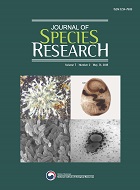A report of nine unrecorded bacterial species in the phylum Bacteroidetes collected from freshwater environments in Korea
이미화 (국립낙동강생물자원관)
한지혜 (국립낙동강생물자원관)
남윤종 (국립낙동강생물자원관)
백기운 (국립낙동강생물자원관)
- 다운로드 수
- 조회수
Abstract
During a comprehensive study of indigenous prokaryotic species in South Korea, nine bacterial species in the phylum Bacteroidetes were isolated from freshwater environmental samples that were collected from three major rivers in the Republic of Korea. High 16S rRNA gene sequence similarity (≥98.7%) and robust phylogenetic clades with the closely related species suggest that each strain was correctly assigned to an independent and predefined bacterial species. There were no previous reports of these nine species in Korea. Within the phylum Bacteroidetes, four species were assigned to the genus Flavobacterium, order Flavobacteriales, and five species to three genera of two families in the order Cytophagales. Gram reaction, colony and cell morphology, basic biochemical characteristics, isolation source, and strain IDs are described in the species description section.
- keywords
- 16S rRNA gene, Bacteroidetes, Flavobacteriales, Cytophagales, unrecorded species
참고문헌
Bowman, J.P., S.A. McCammon, M.V. Brown, D.S. Nichols and T.A. McMeekin. 1997. Diversity and association of psychrophilic bacteria in Antarctic sea ice. Appl. Environ. Microbiol. 63:3068-3078.
DeLong, E.F., D.G. Franks and A.L. Alldredge. 1993. Phylogeneticdiversity of aggregate-attached vs. free-living marine bacterial assemblages. Limnol. Oceanogr. 38:924-934.
Felsenstein, J. 1981. Evolutionary trees from DNA sequences: a maximum likelihood approach. Journal of Molecular Evolution 17:368-376.
Felsenstein, J. 1985. Confidence limits on phylogenies: An approach using the bootstrap. Evolution 39:783.
Fitch, W.M. 1971. Towards defining the course of evolution: minimum change for a specific tree topology. Syst. Zool. 20:406-416.
Glockner, F.O., B.M. Fuchs and R. Amann. 1999. Bacterioplankton compositions of lakes and oceans: a first comparison based on fluorescence in situ hybridization. Appl. Environ. Microbiol. 65:3721-3726.
Jeon, Y.S., K. Lee, S.C. Park, B.S. Kim, Y.J. Cho, S.M. Ha and J. Chun. 2014. EzEditor: A versatile sequence alignment editor for both ribosomal RNA and protein coding genes. Int. J. Syst. Evol. Microbiol. 64:689-691.
Kim, O.S., Y.J. Cho, K. Lee, S.H. Yoon, M. Kim, H. Na, S.C. Park, Y.S. Jeon, J.H. Lee, H. Yi, S. Won and J. Chun. 2012. Introducing EzTaxon-e: a prokaryotic 16S rRNA gene sequence database with phylotypes that represent uncultured species. Int. J. Syst. Evol. Microbiol. 62:716-721.
Ludwig, W. and H.P. Klenk. 2001. Overview: a phylogenetic backboneand taxonomic framework for prokaryotic systematics. Bergey's Manual of Systematic Bacteriology vol. 1, Springer, pp. 49-66.
Ludwig, W., J. Euzeby and W.B. Whitman. 2010. Road map of the phyla Bacteroidetes, Spirochaetes, Tenericutes (Mollicutes), Acidobacteria, Fibrobacteres, Fusobacteria, Dictyoglomi, Gemmatimonadetes, Lentisphaerae, Verrucomicrobia, Chlamydiae, and Planctomycetes. Bergey's Manual of Systematic Bacteriology vol. 4, Springer, pp. 1-19.
O'Sullivan, L.A., A.J. Weightman and J.C. Fry. 2002. New degenerate Cytophaga-Flexibacter-Bacteroides-specific 16S ribosomal DNA-targeted oligonucleotide probes reveal high bacterial diversity in River Taffepilithon. Appl. Environ. Microbiol. 68:201-210.
Saitou, N. and M. Nei. 1987. The neighbor-joining method: a new method for reconstructing phylogenetic trees. Mol. Biol. Evol. 4:406-425.
Tamura, K., G. Stecher, D. Peterson, A. Filipski and S. Kumar. 2013. MEGA6: Molecular evolutionary genetics analysis version 6.0. Mol. Biol. Evol. 30:2725-2729.
- 다운로드 수
- 조회수
- 0KCI 피인용수
- 0WOS 피인용수


